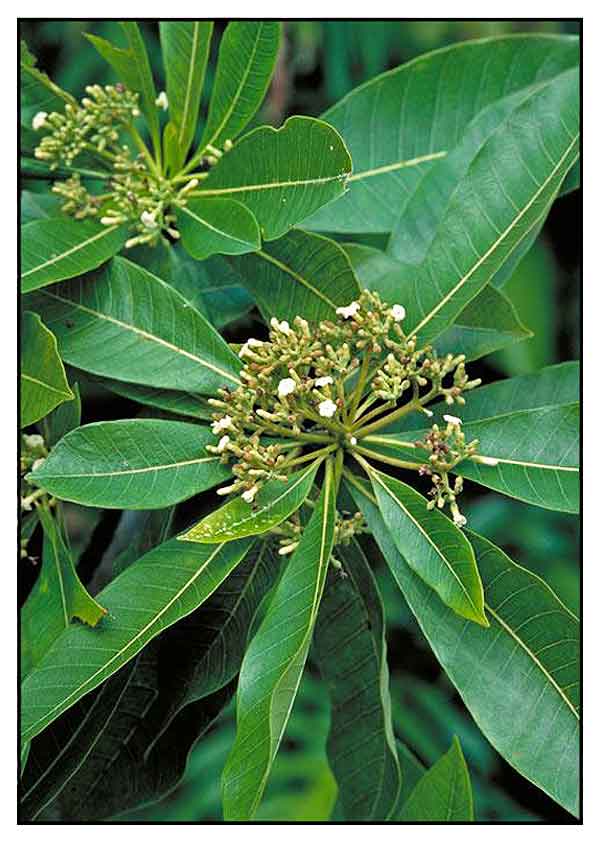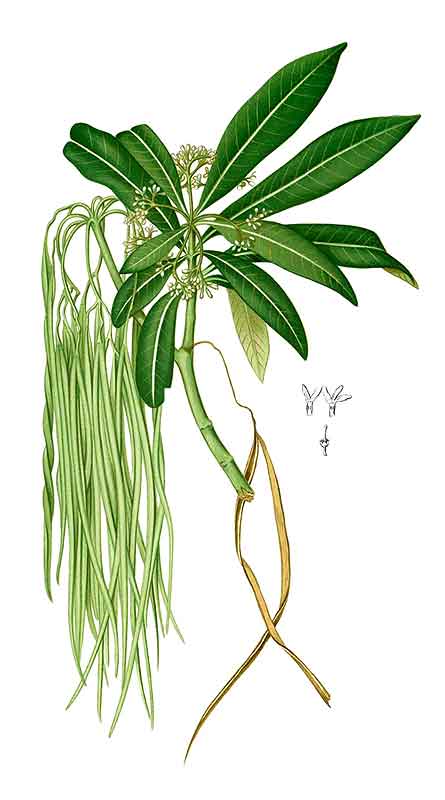 Gen info Gen info
- Alstonia is a widespread genus of evergreen trees and shrubs in the family Apocynaceae. It consists of 40-60 species, with most in the Malesian region.
-
Genus Alstonia was named in 1811 by Robert Brown to honor Charles Alston (1685-1760), professor of botany at Edinburg from 1716 to 1760.
Botany
Alstonia spectabilis is a medium-sized to large tree up to 40 m tall, bole up to 90 cm in diameter, sometimes with small buttresses, outer bark brownish or dark brown, smooth scaly or longitudinally fissured, inner bark yellowish or straw-colored, without latex. Leaves in whorls of 3-4, linear to obovate, 3-32 cm × 1-12 cm, apex acute, obtuse or shortly abruptly acuminate with 10-30(-40) pairs of secondary veins, petiole (0-) 5-27 mm. Inflorescence usually in groups of 2-8, many-flowered. Pedicel 1-3 mm long, calyx subequal, pubescent outside, corolla pubescent outside. Follicles glabrous. (1)
Distribution
- Native to the Philippines.
- Also native to Australia, Bismark Archipelago, Jawa, Lesser Sunda Is., Maluku, New Guinea, Northern Territory, Queensland, Solomon Is., Sulawesi.
- Found in primary and secondary rain forests
at low elevations up to 800 m.
 Constituents Constituents
- GC-EI-MS study of crude bark extract yielded 5-hydroxymethylfurfural (6.01%), 2-methoxy-4-vinyl phenol (0.57%), Vanillin lactoside (1.53%), 2,4-bis(1,1-dimethyl ethyl)-phenol (0.77%), 4-((1E))-3-hydroxy-1- propenyl)-2-methoxy phenol (4.49%), n-hexadecanoic acid (4.18%). Octadecanoic acid (0.62%), [r-(E)]-1,Ethanol-2H-azecino94,3-b] indole-4-ethylidene-1,3,4,5,6,7-hexahydro-6-methylene (0.99%), (3[beta],5[alpha],12[beta],19[alpha],20R)-6,7-didehydro-2,20-cycloaspidospermidine-3-methanol (3.35%), Akummilian-17-oic acid, methyl ester (2.38%), Alstophyllan-19-one (11.00%), campesterol (1.55%), stigmasterol (1.83%), gamma-sitosterol (4.60%), Lupeol (3.39%), (3beta)-24-methylene-9,19-cyclolanostan-3-ol (3.18%). (see study below) (5)
- Examination of the tertiary base fraction from Alstonia spectabilis led to the isolation of villalstonine, macralstonidine, vincamajine, quebrachidine, pleiocarpamine, and AT(,)-methylsarpagine. (9)
- Crude extract of the bark yielded elemental components (<ppm) of Ca (2.571%), K (1.994%), Cl (0.845%), S (0.456%), Si (0.0.368%), Fe (0.009%), Zn (0.003%), with glucose (building block of cellulosic material) consisting of 93.630%. (5)
Properties
- Studies have suggest antimalarial, cytotoxic, anticancer properties.
 Parts used Parts used
Leaves, bark, stems, sap.
Uses
Folkloric
- No reported folkloric medicinal use in the Philippines.
-
In Papua New Guinea, decoction of leaves and bark used for treatment of cough and sore throat. Leaves chewed with betel nut (Areca catechu) and lime to ease the pain of constant coughing.
Decoction of leaves used to treat malarial fever; also used for treatment of asthma. Diluted stem sap applied to tropical ulcers.
(1)
- In the Solomon Islands, plant decoctions is the base of a mixture used as abortifacient.
(1)
- Tetun ethnic people in West Timor Indonesia drink decoction of stem bark for the treatment of malaria.
(3) (4)
- In New Guinea, dried bark is crushed, mixed with water, and drunk to treat malaria, fever, and stomachache. Latex is rubbed into hair to kill head lice. Stems also used for malaria. Stem sap applied externally to tropical ulcers. (6) Leaf decoction used to treat bad cough and asthma. Sap from fresh stem mixed with water used for bad cough. Hot water leaf extract used as abortifacient. (7)
Others
- Wood: Mature timber used for house construction, furniture, flooring, making household implements, and building canoes.
Studies
• Antimalarial / Antiplasmodial / Stem Bark: Study evaluated 50 plant species used by the Tetun ethnic people in West Timor Indonesia for antiplasmodial activity. Alstonia spectabilis showed strong antiplasmodial activity with IC50 of 1.23 µg/mL. (4)
• Cytotoxic Potential / Bark: Study evaluated the cytotoxic potential of A. spectabilis crude bark extracts. The major mineral found in the crude bark extract was calcium (2.571%). Cell viability assay of the extract showed best activity against H69PR with IC50 of 6.95 mug/mL, followed by HT-29 (human colorectal adenocarcinoma) (IC50 7.49), MCF-7 (human breast cancer) (11.06), and THP-1 (human leukemia monocytic) (IC50 66.64 mug/mL.) Results suggest potential as effective chemotherapeutic agent. (see constituents above) (5)
Availability
Wild-crafted.
|

![]()




 Constituents
Constituents
